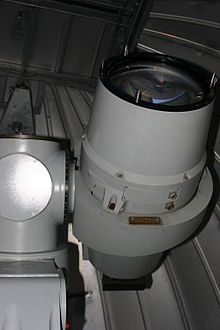Satellite camera
A satellite camera is used for the photographic observation of artificial earth satellites or ballistic missiles against the background of the starry sky .
These special cameras, used on fixed satellite stations , were partly developed before 1957 (the beginning of space travel ). They have typical focal lengths of 30–70 cm with a light intensity of 1: 2 to 1: 5. The usable field of view for panels or film widths of 20 cm is around 20–50 degrees. When using newer CCD sensors , however, the focal length must be reduced.
Well-known camera types
Satellite cameras are distinguished on the one hand by their focal length and on the other hand by the type of mounting. Ballistic cameras are mounted azimuthally (" Altaz "), that is, with a vertical and a horizontal axis, and record the images in a fixed direction. The stars therefore draw short tracks because of the Earth's rotation , the satellites long.
The cameras, which have been further developed from astrographs , on the other hand, track the starry sky so that the reference stars used for the measurement are depicted as points. Some special designs can even track the satellites because they are designed with three or four axes.
Ballistic cameras
The most popular was the BC-4 ballistic camera from the Swiss company Wild Heerbrugg (now part of the Leica Group) with 18x18cm photo plates . The bright camera lens with 1: 2 / 305mm is also available with a longer focal length of 450 millimeters.
A few other cameras were made as prototypes at various university institutes , but mostly did not get ready for series production. Only one IGN camera developed by the Institut géographique national in Paris is more widespread.
Astronomy and photogrammetry cameras
In Russia, two long focal length camera types from astrographs were further developed, the older KFA 1000 (1 m focal length) and the AFU 75 from 1970. Both were built in small series and achieved a measurement accuracy of 1–2 angular seconds . The USA also used cameras from other fields of application in the 1960s, including a. the long-focal length PC-1000 from special photogrammetry tasks . Other cameras are based on the principle of the astronomical Schmidt telescope , such as the satellite observation device ("SBG") developed in the GDR and the English Hewitt camera, which is only built in a few copies .
Multi-axis satellite cameras
The most widespread among the Super Schmidt optics equipped with a special corrector plate is the Baker-Nunn camera , developed in 1956 and mounted on three axes, with the then extraordinary focal ratio of 1: 1 and 50 cm focal length, in which the quickly transportable film strip attaches to the curvature of the Image plane is adjusted.
The most technically sophisticated satellite camera is probably the BMK 75 from Zeiss Oberkochen . Specifically for Satellitengeodäsie and Astrometrie developed measuring camera has a focal length of 75 cm and an aperture ratio of 1: 2.5. In addition to extremely low optical distortion (only 1–2 µm, which eliminates the need for special distortion correction due to the similarly high measurement accuracy ), it has a sophisticated system for rapid plate change , which enables numerous recordings to be made during a single satellite pass. Among the cameras delivered, those at the fundamental stations in Wettzell (Bavarian Forest) and Graz-Lustbühel (Styria) are among the cameras with the highest number of observations worldwide.
However, since the photographic satellite triangulation and satellite geodesy has lost importance since the SLR laser development compared to the now more precise trilateration , these cameras are partially converted to CCD sensors and used for astronomy (search for small planets , observation of comets , variable stars, etc. .); some have also been tested for use as astrogeodetic zenith cameras (TU Vienna, University of Bern).
Observation technique
The track of the satellite (and the fixed stars that are also photographed ) is chopped up into short pieces by means of a rotation lock , which can be measured to ± 1 " using astrometry methods (see also stereo comparator ). Three types of mounts are in use:
- the azimuthal mount has a vertical and a horizontal axis (used with the ballistic camera )
- the equatorial mount (also known as parallactic mount ) tracks the stars. One of the axes is aligned to the celestial pole (as with observatory telescopes)
- the multi-axis mount has three or four axes. It can be tracked closer to the satellite. The most famous camera is the Baker-Nunn .
For the purposes of satellite geodesy, special star catalogs were calculated, e.g. B. the SAO catalog with 259,000 stars.
In the last few years the measurement method has lost its importance because the accuracy of modern distance measurement to satellites is around 10 times higher ( time of flight measurement with laser or microwaves). This is why some of these cameras have been converted to CCD sensors or adapted for astronomical purposes such as observing comets or asteroids .
See also
literature
- Günter Seeber: Satellite geodesy. de Gruyter, Berlin 2003, ISBN 3-11-017549-5 ; Cape. 5.1.2, p. 163 ff .: Satellite cameras at Google Books
- J. Weingrill et al .: Ground Based Wide-Field Photometry with the Zeiss BMK. Abstract at uni-graz.at (pdf; 1.1 MB)
- AG Massevitch, AM Losinsky: Photographic Tracking of Artifical Satellites , Space Science Review, 1970

